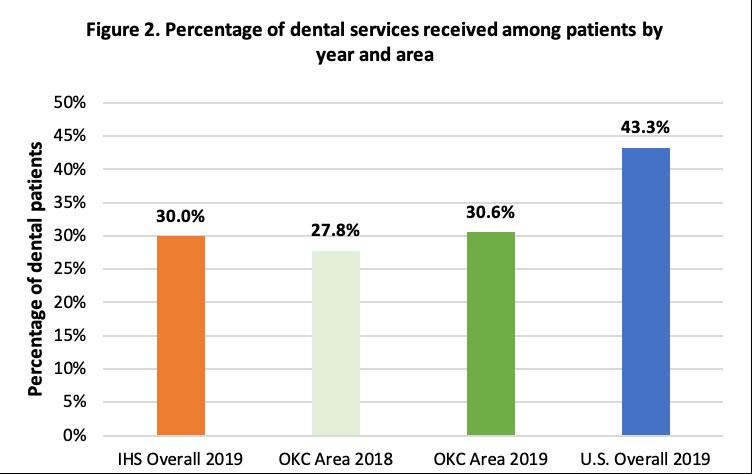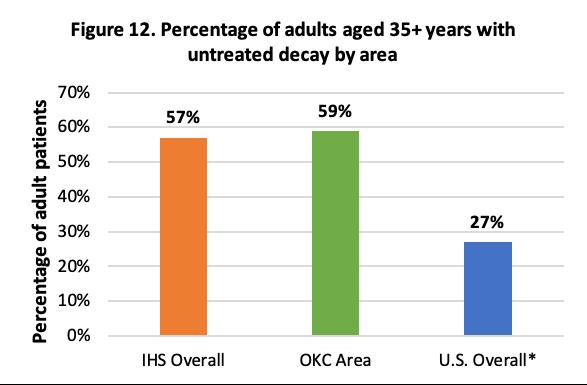
15 minute read
Untreated Decay
AI/AN adults suffer disproportionately from poor oral health outcomes such as untreated caries, periodontal disease, missing teeth and lack of access to dental care, relative to the general U.S. adult population. Many of the oral health services provided by the IHS are focused on children, resulting in limited availability of services for adults. There is a critical need to increase preventive and restorative services for adults.
In 2015, results from the IHS OKC Area indicated about 8% of adults established a patient exam, 31% of adults had a hygiene appointment, 11% of adults had a new patient exam, 14% of adults had a restorative appointment, 32% of adults had a dental visit for a walk-in or emergency purposes, and about 2% of adults visited the dentist for other reasons. Further, only 30.6% of adults visited a dentist in the past year.
Advertisement
UNTREATED DECAY
The following compares the 2015 reported results of AI/AN adult dental patients aged 35+ in IHS Overall, the IHS OKC Area and the general U.S. population.4,23
Tooth decay can affect people of all ages.
The use of fluoride, good oral hygiene, limited consumption of foods high in sugars and starches, not using tobacco products, and routine dental check-ups and cleanings can help prevent tooth decay.4, 9
*U.S. data comes from NHANES 2011-2012 report for adults aged 20-64 years
Please note the IHS OKC specific data citation for this section is as follows: Phipps, K.R. (2020). [2016-2017 IHS Oral Health Survey of AI/AN Adult Dental Patients Aged 35+ Years]. Unpublished data.
MODERATE TO DEEP POCKETS
The following compared the 2015 reported results of AI/AN adult dental patients aged 35+ in IHS Overall, the IHS OKC Area, and the general U.S. population.4,14
Moderate to deep pocketing is an indicator of periodontal disease. Periodontal disease is a form of gum disease wherein the tissues that hold teeth in place become infected.4, 24 Poor dental hygiene, diabetes and smoking can greatly increase the risk of gum disease, as bacteria in the mouth (plaque) can build up on the teeth and harden. If left untreated, periodontal disease can result in sore, bleeding, painful gums, and loss of bone that holds the teeth in the jaw.4, 24
Similarly to dental caries prevention, regularly brushing teeth with fluoride toothpaste, flossing, not using tobacco products, and routine dental check-ups and cleanings can help keep gums healthy.4, 24

*U.S. data for 45-74-year-old adults from 2014
The following compares the 2015 reported results of AI/AN adult dental patients aged 35+ in IHS Overall, the IHS OKC Area and the general U.S. population.4,23
In 2015, 83% of AI/AN patients aged 40-64 years reported having had teeth pulled because of tooth decay or gum disease in IHS overall.4 Records from 1991 in the IHS OKC Area indicated that 15% of adults 20 years and older needed teeth extracted due to tooth decay or gum disease.11
The IHS overall average of decayed, missing and filled permanent teeth among adults aged 3444 years was 14% in 1991.11 The IHS overall prevalence of tooth loss for adults aged 35-44 years is 71%, whereas the IHS OKC Area prevalence was 73% in 2015.4, 12
For the general U.S. population, HP 2020 reported about 72% of adults aged 45-64 years reported tooth loss due to dental caries or periodontal disease between 2013-2016.14

*U.S. overall data from 2013-2016
Please note the IHS OKC specific data citation for this section is as follows: Phipps, K.R. (2020). [2016-2017 IHS Oral Health Survey of AI/AN Adult Dental Patients Aged 35+ Years]. Unpublished data.
According to the 2015 reported results from the survey of AI/AN adult dental patients aged 35+, AI/AN patients are more likely to report poor/fair oral health, painful aching in the mouth and avoiding certain foods due to issues in the mouth.4 Poor or fair oral health can be the result of oral pain experienced by patients.
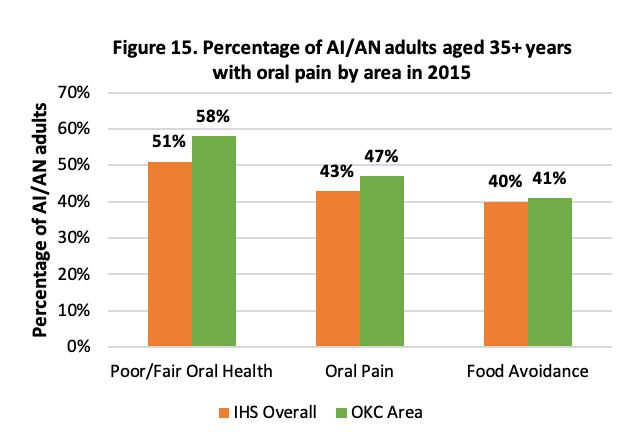
Please note the IHS OKC specific data citation for this section is as follows: Phipps, K.R. (2020). [2016-2017 IHS Oral Health Survey of AI/AN Adult Dental Patients Aged 35+ Years]. Unpublished data.
DENTIST TO POPULATION RATIO
The IHS Congressional Budget Justification for 2021 reported that there was approximately one dentist per 2,830 patients in the IHS system.13 Currently, there are no published dentist to population estimates for the IHS OKC Area. After identifying filled dentist positions from tribal and IHS-operated clinics in the IHS OKC Area and supplementing with the NPI registry, it was found there are approximately 121 dentists working in Indian Health Service, Tribal Nations, and Urban Indian Facilities (ITUs). According to the FY 2019 IHS OKC Area User Population Report, there are 388,486 users in this area.25 This indicates there is approximately one dentist per 3,210 users in the IHS OKC Area as of 2019. By comparison, according to the American Dental Association, the dentist to population ratio for the state of Oklahoma is one dentist per 2,018 users. The general U.S. population ratio is one dentist per 1,638 users.26
Figure 16. Dentist to Patient Ratio
1 Dentist in IHS OKC Area Per 3,210 AI/AN Patients
1 Dentist in IHS Overall Per 2,830 AI/AN Patients
1 Dentist in OK State
1 Dentist in U.S. Per 2,018 Patients
Per 1,638 Patients
WATER FLUORIDATION IN OKALHOMA
Community water fluoridation is a cost-effective method to deliver fluoride to communities regardless of age, educational attainment, or income level.19, 27 Residents living in areas with water fluoridation have 25% fewer cavities than those living in communities without fluoridation.2 Water fluoridation saves money for families and the healthcare system; it is an effective strategy to eliminate population health disparities and promote social justice. According to a 2010 report from the Pew Center on the States, with every dollar invested on water fluoridation, a person saves up to $38.00 in oral health treatment costs annually. Recent evidence continues to indicate that the economic benefit of community water fluoridation exceeds the intervention cost. Further, the benefit-cost ratio increases with the community population. Figure 17 displays the 2017 status of water fluoridation in Oklahoma as reported by the Oklahoma State Department of Health.27, 29
Figure 17. Water Fluoridation Status in Oklahoma in 2017

Image Source: https://www.ok.gov/health2/documents/FluoridatedWater_20170320.pdf
Community water fluoridation is the single most effective public health intervention to prevent tooth decay, reducing decay by more than 25% across the lifespan.30 Drinking water with fluoride protects the minerals in tooth enamel, keeping teeth strong and solid. Health benefits include less pain and suffering because of tooth decay.
In Oklahoma, approximately 70% of the population receives fluoridated water8 in comparison to 73%30 of the U.S. population.15 There is no state mandate to fluoridate nor are there rules requiring notification if a community ceases the service. The most populous cities of Oklahoma City and Tulsa fluoridate, which encompasses almost half of Oklahomans on public water supplies. In Oklahoma, decisions about adding fluoride to drinking water are made at the local level. The Oklahoma State Department of Health, Dental Health Service, assists communities through education and promotion. The Oklahoma Department of Environmental Quality is the regulatory agency for water fluoridation; they enforce the EPA standards. Fluoride is present in all water sources. Community water fluoridation is the adjustment of fluoride in drinking water to a level that prevents tooth decay.30
There are many challenges to the continuation of water fluoridation: maintenance costs, infrastructure costs, poor economy, misinformation, and lack of perceived value by city officials and the public. Identifying local champions to advocate for public health is a key strategy when facing opposition or apathy toward fluoridation.
According to the CDC, 73% of the total U.S. population on community water systems had access to properly fluoridated water. In addition, HP 2020 aims for 80% of the U.S. population on community water systems to have access to fluoridated water.30 Recently, opposition to fluoridation has been growing worldwide, emphasizing the potential and serious risk of toxicity when factoring in additional modalities of fluoride intake.31 However, over 70 years of studies and practical experience overwhelmingly merit the safe and equitable public health benefits of community water fluoridation. The CDC recognize fluoridation of drinking water as one of the Ten Great Public Health Achievements of the 20th century.30 Fluoridation of drinking water is endorsed by the American Medical Association, the American Academy of Pediatrics, and the World Health Organization.
The rural population in the U.S. comprises approximately one-fifth of the total population, and approximately 20% of racial/ethnic minorities live in rural areas.32, 33 Evidence has shown that populations in rural areas have a lower frequency of dental visits compared to populations in urban areas,34, 35 and this may be even more prevalent among dental health professional shortage areas. Access to dental providers is one of the most common factors cited as a cause of rural oral health disparities. It is difficult to recruit dental providers to rural areas because Figure 18. Dental Health Professional Shortage Areas of comparatively within Oklahoma Tribal Land lower salary and revenues, the capital needed to start a rural practice, and unwillingness to live in rural regions, among other reasons.36 Dental health professional shortage areas (Dental HPSAs) are areas designated by the Health Resources and Services Administration (HRSA) Bureau of Health Workforce (BHW) as having too few dental health care providers, relative to the size of its population. Dental HPSAs are areas of greatest oral health care need. Residents who live in these areas are at risk of a lack of access to quality dental care because the needs of the community exceed provider capacities. Figure 18 displays the dental health professional shortage areas as indicated by the red dot in the legend within Indian lands and Native entities.36 The image signifies the scarce availability of dental care available to AI/AN populations on tribal land.36
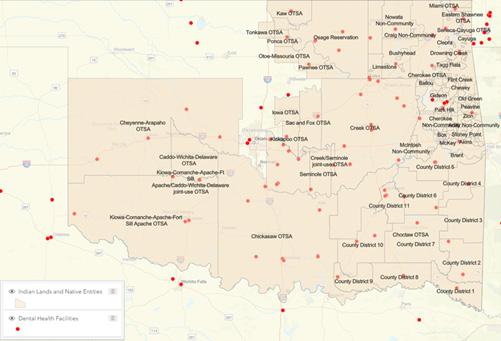
AI/AN peoples are often denied preventive and restorative dental services such as endodontic care, crowns, bridges, dentures, and surgical extractions because the IHS is severely underfunded. With that, most basic, emergency care services, as well as restorative and preventive care, are provided primarily for children.37, 38
Further, the relative geographic isolation of Tribal populations and the difficulty of recruiting physicians/dentists to practice in TTUs within rural areas are other major impediments to providing IHS benefits to larger populations.38 Because there is such a large burden of disease among this population, even if all available positions for dental providers serving AI/AN communities were filled, the dentist to population ratio may still be insufficient.38
Evidence has shown the implementation of dental therapists to underserved populations may greatly improve oral burden of disease amongst the AI/AN population. Moreover, programs that focus on early, preventive, restorative and lifetime treatment would further improve oral health outcomes.
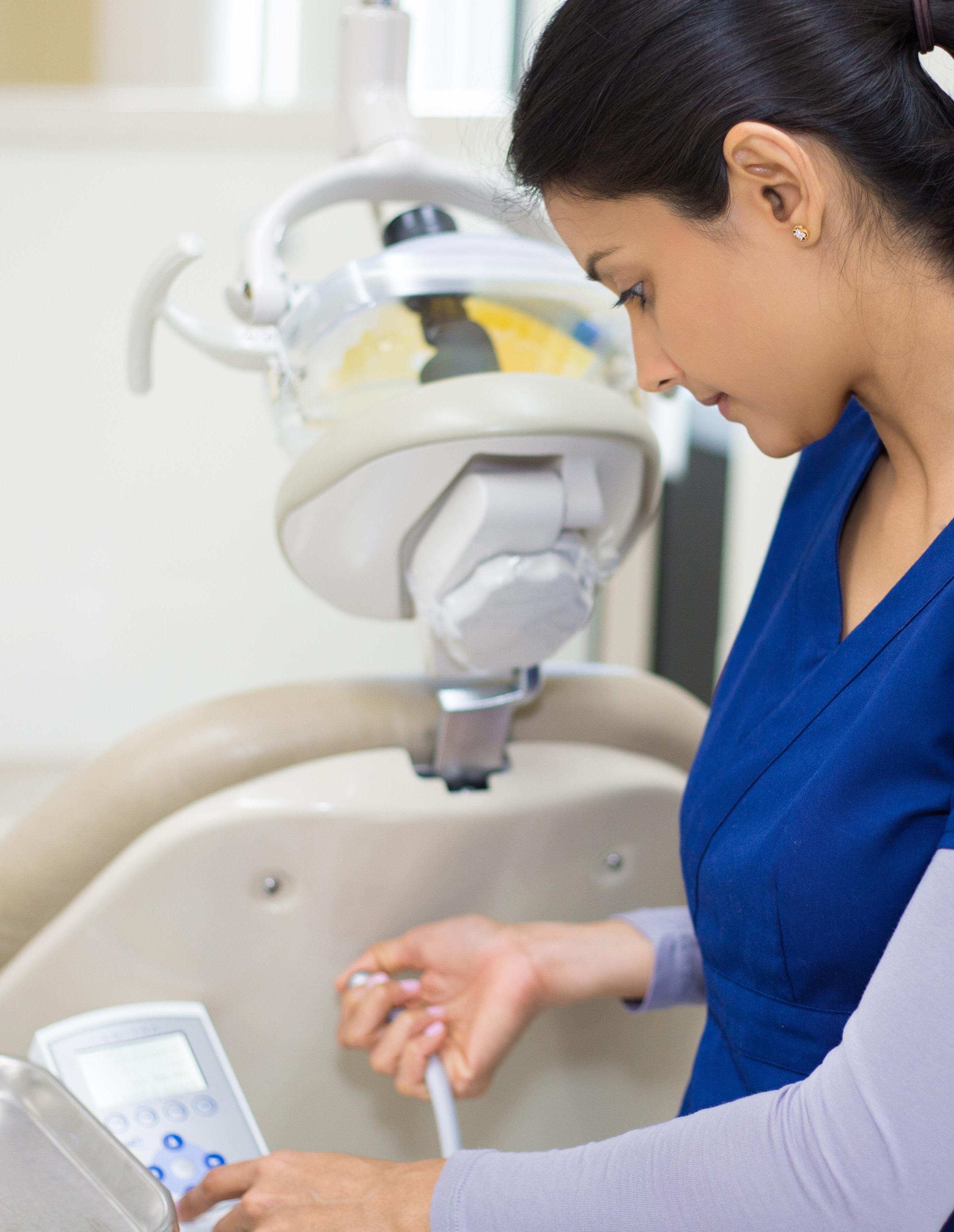
Oral health is a social justice issue. American Indian and Alaska Natives (compared to nonAmerican Indian or Alaska Native ethnic groups) are more likely to experience oral health disparities. According to the 2010 Census, 0.9% of the U.S. population, or 2.9 million people identified as AI/AN alone. Further, about 12%, or 5.2 million people identified as AI/AN alone or in combination with another race. In Oklahoma, roughly 10% identify as AI/AN alone.39 That AI/AN populations suffer disproportionately indicates that the foundations of healthcare, government, and educational services are rooted in injustice. Due to historical and ongoing systemic injustices, AI/AN populations do not have access to “YOU NEVER CHANGE THINGS timely and quality health services, including but not limited to, oral health. However, increasing transparency BY FIGHTING THE within these systems, acknowledging historical context, and establishing multi-disciplinary teams can greatly EXISTING REALITY. improve health care, including oral health. TO CHANGE Unfortunately, in several key indicators, comparisons SOMETHING, of bad to worse are outlined throughout the report. There are alarmingly significant gaps in cost-effective, BUILD A NEW evidenced-based preventative treatments such as fluoride varnish applications and dental sealant placements. For MODEL THAT example, 48% of Medicaid users received a fluoride varnish treatment in 2018, compared to only 32.1% MAKES THE among IHS overall and an astoundingly low 27.6% for the IHS OKC Area in 2019 (GPRA). The national GPRA target is set at only 30%, how does that promote the value of preventative care and further contribute to the egregious EXISTING MODEL OBSOLETE.” oral health disparity? -BUCKMINSTER FULLER Further, in 2020, the Oklahoma Oral Health Coalition released a statewide oral health report card. That report found that, when compared to the nation’s performance on 13 key oral health indicators, Oklahoma scores a “D.” Oklahoma, the IHS OKC Area, and the nation can do better.40 However,
innovative strategies, including those aimed at merging oral health care and prevention, are showing some progress. The ECC Collaborative, an IHS program, is one such multi-faceted effort. It educates dental providers, as well as other health care workers and the community itself, about preventing ECC and early intervention to reduce the harm of tooth decay. The program was designed to promote ECC prevention by focusing on proven oral health strategies, such as early access to dental care, fluoride varnish applications, sealants (for primary teeth and permanent teeth), and interim therapeutic restorations. The ECC Collaborative also initiated the ongoing oral health surveillance system referenced earlier in this report.
The expansion of the Community Health Aide Program (CHAP) to the lower 48 states is one approach toward helping our communities achieve optimal oral health. CHAP is a multidisciplinary system of mid-level behavioral, community and dental health professionals that work alongside licensed providers to offer patients increased access to quality care. Under the CHAP, tribes and IHS facilities have the opportunity to add new mid-level dental providers, such as dental health aide therapists (or dental therapists) to the dental team. Under their scope of work, DHATs can fill cavities, place temporary crowns, and perform uncomplicated tooth extractions, while dentists tend to more complex, revenue-generating procedures. Dental therapy has been gaining momentum across the country to provide preventive and routine restorative care to geographically isolated and underserved tribal communities. Evidence shows that dental therapists have improved access to safe, culturally relevant oral health care in tribal communities.
Further, 638 tribally-operated programs have been utilizing innovative approaches to address oral health disparities. They include training Community Health Representatives (CHR) to be Community Dental Health Coordinators (CDHC). CDHCs provide community-based prevention, care coordination, and patient navigation to link services to individuals who do not typically receive dental care in underserved rural, urban, and AI/AN communities. Thus, culturally relevant, community-based oral health programs can serve as the pillars of a thriving, healthy community.41 In the wake of the COVID-19 pandemic, the oral health disparities mentioned in this report have been exacerbated by less access to care and widespread cancellation of community events that promote good oral hygiene and provided oral health education to adults and children. Oral health stakeholders, policy-makers, and insurers are looking at ways to integrate care with teledentistry platforms and processes to mitigate the ripple effects of the COVID-19 pandemic. Tribal leaders in Oklahoma and abroad are paving the way for these innovations to continue to provide care and support to Native communities.
The Oral Health Progress and Equity Network (OPEN) was formed in 2013 to address oral health inequities through a social justice and health equity lens. This national network includes representatives from all 50 states who are working at every organizational level to improve oral health for all. Members of OPEN regularly engage in learning from groups across the country working on social justice and health equity to identify challenges, opportunities, and skills that can help move their own work forward alongside the work of improving oral health. Members learn about oral health among key socioeconomic groups, about culturally competent approaches to oral health, and about thoughtful public policy ideas that may reduce health disparities. Over the last decade, OPEN has created a movement, sparking a nationwide conversation that includes policymakers, providers, public health activists, and grassroots organizers. The results of this conversation are an acknowledgement that the system of healthcare in place today is not working for the most vulnerable.
The data outlined in this report offer a snapshot of the current oral health status of AI/ANs living in the IHS OKC area. To address the oral health crisis in Indian Country locally and abroad, a multimodal approach that engages the individual, family, community, Tribal leadership, plus health and social service providers must be developed, implemented, and sustained. This multimodal approach should combine primary, secondary, and tertiary prevention strategies layered with strategies to increase access and systemic changes to reduce the consequences of social inequities.42
The Native Oral Health Network represents one such strategy working to intertwine these layers by providing a platform for individuals and organizations to capitalize on the empowerment of connection for a common purpose and goal. It is NOHN’s mission to build healthier Native communities by connecting oral health to overall health and wellness through peer support, collaboration, and community engagement. The NOHN is the first oral health network in Oklahoma focusing on Native communities, and since 2017, NOHN has worked to build a resource library, build capacity to amplify the community voice, and work with stakeholders to identify solutions for a better quality of life for Native peoples. To those ends, NOHN has increased primary data collection efforts that increase the oral health data available for the IHS OKC Area through SPTHB’s Tribal Behavioral Risk Factor Surveillance Survey (TBRFSS) that will contribute to future versions of this report.
A mental model shift of the notion that oral care can and should only be provided in a dental clinic must occur for disparity gaps to close. Public policies and organizations should invest in oral health promotion, prevention, and community-based health programs. By utilizing the entire dental team to the full extent of their scope of practice and license, and adding dental therapists, there is an opportunity to expand accessible and affordable dental services to underserved AI/AN communities inside and outside the clinic doors. More concerted efforts should focus on addressing the social determinants of health and shift from acute care and treatment to chronic disease prevention and management. Additionally, prevention and health behavior science should integrate with oral health care and promotion activities.

